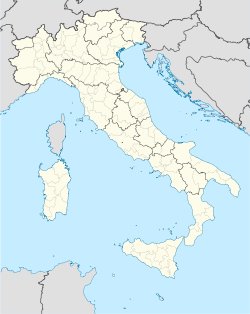- Mola di Bari
-
For other uses, see Bari (disambiguation).
Mola di Bari — Comune — Comune di Mola di Bari Aerial view of Mola di Bari 
Coat of armsLocation of Mola di Bari in Italy Coordinates: 41°4′N 17°5′E / 41.067°N 17.083°ECoordinates: 41°4′N 17°5′E / 41.067°N 17.083°E Country Italy Region Puglia Province Bari (BA) Frazioni Cozze, San Materno Area – Total 50 km2 (19.3 sq mi) Elevation 5 m (16 ft) Population [1] – Total 25,919 – Density 518.4/km2 (1,342.6/sq mi) Demonym Molesi Time zone CET (UTC+1) – Summer (DST) CEST (UTC+2) Postal code 70042 Dialing code 080 Patron saint San Michele; Madonna Addolorata Website Official website Mola di Bari, more commonly referred to simply as Mola, is a small coastal town of about 26,000 inhabitants located approximately 22 kilometres south of Bari in the Southern Italian region of Apulia (Puglia).
In recent times, it was best known for having primarily whitewashed buildings, however, growth, modern construction and building design have changed the image significantly, particularly in the northern (and more modern) section.
Mola city centre is its main piazza, Piazza XX Settembre near the port and also boasts a church (Chiesa Matrice, i.e. Mother Church) dating back to the 13th century. Bakeries in Mola are known to make some of the finest focaccia in Italy.
Until the early 1990s, there were two privately owned public ovens available to the inhabitants of Mola, one located on Via Nino Bixio, on the southern part of the town, and the other located on Via Pesce, on the opposite side of the main Piazza. These businesses served the local residents by providing a place to cook baked goods, primarily focaccia and breads. Typically, focaccia pans were quite large (some approaching half a meter in diameter) and were difficult to cook in one’s home. The tradition of sending items to be baked by the local oven has passed.
Mola is also home to a large fishing industry that supplies fresh fish throughout the southern Italian region.
Contents
History
The old settlement of Neolithic people is confirmed by some archeological remains. The origin of the city is not entirely known because of lack of sufficient traces to assert a Greek origin (coins now dispersed, an old emblem showing the symbol of Athens) or Roman (a Roman villa of the imperial period close to the Northern coast and the remains of a water tank). The proof of the existence of an urban settlement remain scarce and contradictory up until 1277, when Charles I of Anjou ordered the reconstruction of the city along with the building of city walls, a church and a castle.
Under the control of various feudal families (Macedonio, Gesualdo, Maramaldo, Toraldo, Carafa, Vaaz), only in 1670 Mola was able to get rid of remnants of feudal power and to restore its original status within the Kingdom of Naples.
Picture gallery
Famous people
Niccolò van Westerhout (Mola di Bari, 1857 - Naples, 1898). Musician and composer
Piero Delfino Pesce (Mola di Bari, 1874–1939). Journalist and politician
Onofrio Martinelli (Mola di Bari, 1900 - Florence, 1966). Painter
Bruno Calvani (Mola di Bari, 1904–1986). Sculptor
Mario Battista (Mola di Bari, 1934 - Rome, 2000). Figurative painter and portraitist. He shared his career between teaching and painting.[2]
Vito Tanzi (Mola di Bari, 1935-) Economist
Giuseppe Avelluto ( Mola di Bari, 1940-) Restaurateur
Main Streets
Via Piero Delfino Pesce is a street running along the seafront on the north-western part of town. It is named after one of Mola's famous inhabitants listed above.
Via Giuseppe di Vagno is a street running parallel to the "lungomare", on the southeastern part of town. The street is named after Giuseppe di Vagno, a socialist politician who was killed by fascists after a political rally held in Mola di Bari in September 1921
Corso Umberto is a street that runs southwest, starting next to the church in the main Piazza, ending near Piazza degli Eroi (Piazza of the Heroes), also known as San Domenico
References
External links
- www.comune.moladibari.ba.it - Official Municipality Site
- www.ambientemola.it - Ambient Councillor's Site and forums (update frequently)
- www.moladibari.com - News from Mola and forums (update frequently)
- "Lo Spiraglio" Local monthly newspaper
- Mola di Bari from Satellite (Google Local)
- Site on Doña Flor, van Westerhout's opera
- Article on the Mola di Bari community in the USA "The Other Mola", Tiziano Thomas Dossena, L'Idea.N.33, 2008
Puglia · Comuni of the Province of Bari Acquaviva delle Fonti · Adelfia · Alberobello · Altamura · Bari · Binetto · Bitetto · Bitonto · Bitritto · Capurso · Casamassima · Cassano delle Murge · Castellana Grotte · Cellamare · Conversano · Corato · Gioia del Colle · Giovinazzo · Gravina in Puglia · Grumo Appula · Locorotondo · Modugno · Mola di Bari · Molfetta · Monopoli · Noci · Noicattaro · Palo del Colle · Poggiorsini · Polignano a Mare · Putignano · Rutigliano · Ruvo di Puglia · Sammichele di Bari · Sannicandro di Bari · Santeramo in Colle · Terlizzi · Toritto · Triggiano · Turi · ValenzanoCategories:- Cities and towns in Apulia
- Communes of the Province of Bari
- Coastal towns in Apulia
Wikimedia Foundation. 2010.












